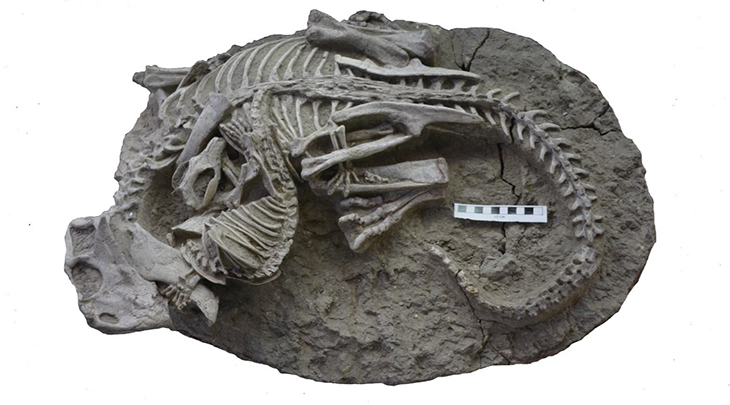
Paleontologists have made an astonishing discovery in China’s Liaoning Province. While this is a remarkable find, it may not be as surprising as one might think considering this area is often referred to as ‘Dinosaur Pompeii’ due to its extensive wealth of well-preserved fossils. However, this particular find shows an exceptionally fossilized scene of a dinosaur being attacked and devoured by a mammal.
This incredible find showcases the intertwined remains of a beaked and horned herbivorous dinosaur and a smaller meat-eating creature known as Repenomamus. This ancient duo were found entombed by a mudslide, forever captured in this dramatic moment in time.
Significantly, this discovery is one of the earliest examples of predatory behavior by a mammal toward a dinosaur.
According to the co-author of the English language paper written about its discovery, Dr. Jordan Mallon from Ottawa’s Museum of Nature, “The two animals are locked in mortal combat—intimately intertwined. The weight of the evidence suggests that an active attack was underway.”
Upon close examination, it becomes evident that the dinosaur, a Psittacosaurus roughly the size of a large dog, lies prone with its hindlimbs neatly folded on either side of its body.
Meanwhile, the weasel-like Repenomamus, the largest mammal of the Cretaceous period, is coiled to the right, perched atop the dinosaur. It grips the prey’s jaw while biting into its ribs, and its back foot is firmly clutching the hind leg of the Psittacosaurus.
Taking a closer look at what they found, the research team ruled out scavenging as the cause of death for the dinosaur since there were no tooth marks on its bones. Plus the entangled position of the two creatures also makes it improbable that they simply became trapped together. Furthermore, Repenomamus was known to have preyed on Psittacosaurus due to fossilized baby bones of the herbivorous dinosaur being found in the mammal’s stomach.
Due to the elevated position of the Repenomamus, it also suggests that it was the aggressor between the two.
This behavior echoes the modern world, where solitary predators, such as lone wolves, are known to hunt larger prey, like caribou and domestic sheep. At the same time, members of the Mustelidae family, which include weasels, martins, and stoats, tend to prey on significantly larger mammals like rabbits, on a regular basis.
The fossil site at Lu Jia Tun holds additional treasures, including the remains of small mammals, amphibians, and lizards that were suddenly buried by mudslide debris following nearby volcanic eruptions.
In his paper, Dr. Mallon expressed confidence that these fossil beds will continue to yield even more insight into the interactions among species that were previously unknown to the scientific community.
What are your thoughts? Please comment below and share this news!
True Activist / Report a typo


